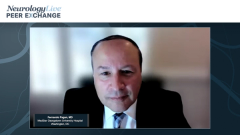
Surgical Options and Emerging Treatments for Parkinson Disease
Drs Fernando Pagan, Robert A. Hauser, and Daniel Kremens highlight existing and emerging surgical and pharmacological options for treatment of dyskinesia in Parkinson disease.
Episodes in this series

Daniel E. Kremens, MD, JD: Fernando, although today’s discussion focused on medications for dyskinesia, could you discuss any existing and emerging surgical options for patients whose symptoms may not be adequately controlled with medication?
Fernando Pagan, MD: The main surgical options that we have are deep-brain stimulation. We have the option of going to the STN [subthalamic nucleus] or GPI [globus pallidus internus] when we use deep-brain stimulation for patients who are having these motor fluctuations. If somebody has a little more dystonia and dyskinesia, one could use the GPI as a target for deep-brain stimulation. The other option is the STN, which allows for a greater reduction of oral levodopa dosing. With the increase in on-time and the reduction in the levodopa dosing, you may see less OFF time and more ON time without troublesome dyskinesia and a reduction in overall dyskinesia, because you’re using less levodopa and more of the deep-brain stimulation.
There are some studies being done using the MRI-guided focused ultrasound. Most of that has been for tremor, but there’s some work being done looking at the GPI as a potential target. Most of the previous studies have been unilaterally using the VIM [ventral intermediate nucleus thalamotomy], which is a target for essential tremor and Parkinson disease, but the GPI is being looked at as a potential target with focus ultrasound. Previous lesioning studies in the past had shown improvement in tremor and some of these motor fluctuations with different types of lesioning. The long-term efficacy after lesioning these different targets has always been a little questionable in Parkinson disease, especially with the old way of lesioning them or using Gamma Knife or CyberKnife. These things need further studies, but MRI-focused ultrasound is looking at these potential targets in the future.
Daniel E. Kremens, MD, JD: Bob, would you like to comment on potential emerging therapies in dyskinesia that you’re excited about?
Robert A. Hauser, MD, MBA: I know of 2 medications that are in clinical trials. One is dipraglurant, which is a noncompetitive inhibitor of MGLUR5. There’s some suggestion that it may have both anti-Parkinsonian and antidyskinetic effect. We’ll see; trials are ongoing. There’s also a medication labeled JM-010, which is a combination of buspirone and zolmitriptan. It’s an agonist, 5-HT1A and 5-HT1B/D, and it too is in clinical trial. We’ll see how those studies turn out.
Daniel E. Kremens, MD, JD: It’s interesting. As you mentioned, there’s been the glutaminergic approach. There was another metabotropic glutamate receptor 4 product that failed in its phase 2 trial. That development program was discontinued, and now we’re looking at the MGLUR5 to see if we get the benefit there. Early studies have been encouraging. You also mentioned the serotonergic pathways that we’re looking at with the buspirone combo product. There have been some epidemiologic data looking at patients who are on SSRIs [selective serotonin reuptake inhibitors] and dyskinesia, which has been interesting to suggest that it would potentially be beneficial looking at that serotonin pathway. Another 1 that had an open-label phase 4 trial—it hasn’t been published, so I don’t know the results—is zonisamide. In my clinical experience, before we had DR/ER [delayed release/extended release], I’d sometimes use this in patients. I saw some clinical benefits. I was hoping to see what happened with that study.
There have been some other interesting drugs. There was a drug originally developed for Huntington disease that has been looked at, but because of COVID-19, enrollment in that study may have ceased. I don’t know if it’s going to be continued.
Rajesh Pahwa, MD: That study has been withdrawn.
Daniel E. Kremens, MD, JD: It’s been withdrawn. There are several interesting potential targets for the treatment of dyskinesia in the future.
Rajesh Pahwa, MD: It also shows how difficult it has been trying to find a treatment for dyskinesia, and it’s not for a lack of trying. We have tried multiple agents at multiple neurotransmitter levels and haven’t been successful.
Daniel E. Kremens, MD, JD: There have even been studies, which I believe are ongoing, looking at D3 receptors. So there are lots of different targets. It shows how complicated the pathophysiology of dyskinesia is.
Transcript Edited for Clarity
Newsletter
Keep your finger on the pulse of neurology—subscribe to NeurologyLive for expert interviews, new data, and breakthrough treatment updates.





























